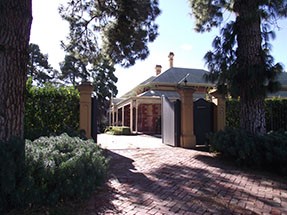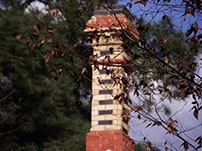Lyndhurst
'Lyndhurst' Paradise received its name from one of the early pioneers. He was Joseph Ind, and Paradise was the name of a property near his home in Tetbury, England. In a letter to the Adelaide Observer in 1889, he signed the article, Joseph Ind, Little Paradise on the Torrens.1 The estate owned by the Ind family, was known as “Paradise Farm”. When a bridge was built over the river Torrens, Joseph built a hotel close by, and named it the Paradise Bridge Hotel. Paradise had become the accepted name for the area.
The original house named ”Lyndhurst”, was a four room cottage built around 1860. In 1888 Lyndhurst was owned by George Frederick Ind, son of Joseph Ind. When George Frederick’s son, Howard Henry Ind married, he moved into the house with his new bride Matilda Dawson, nee Beaglehole.2 An architect by profession, Howard Ind set about enlarging the house. He added five more rooms to the original cottage. Having spent time in Italy learning his profession, he imported the latest ideas from that country, like door leadlight and marble fireplace surrounds. The tessellated tile chimneys, and the decorative metal work, were constructed in Adelaide. Two daughters and a son were born to the couple between 1889 and 1893.


Lyndhurst Paradise and tessellated chimney. Photo by Jim Nelson 2017
In August 1906, Howard Henry Ind was declared insolvent. He was of the belief that he was the owner of Lyndhurst, and his debts could be covered. His lawyer advised him, that his father had never actually gone through with the transfer of the property into his name. Howard Ind, aware of the cost that he had incurred on enlarging the property, asked his lawyer to place a lien on the title. The lien was for £929. Howards Ind’s creditors were asked to accept 5/- (shillings) in the pound to settle their debts.3 After the death of Howard’s father, (G.F.Ind) in 1906, the creditors again attempted to recoup their debt. The trustees of G.F.Ind’s estate agreed to do a deal with the trustees of Howard Ind’s insolvent estate. The lien on the title (£929) was cancelled, as was the debt for rental (£1,800) against Howard, for the period of time he had occupied the property. The agreement also stated that Howard Henry Ind would forfeit any payment from the estate of his father. That being settled Lyndhurst was sold at public auction.4 Howard’s creditors initiated court action for fraud. The Judge found no evidence of fraud existed, and they, (the creditors), had been truthfully advised at all times. Costs were awarded against the creditors.
By 1908 Lyndhurst had been sold to Mrs. H.E. MacDonald. Henriette MacDonald was the proprietor of MacDonald’s Grand Coffee Palace in Hindley Street Adelaide. In the 1880’s coffee palaces and temperance hotels became very popular with travelers, they were exactly like hotels, except without alcohol. Temperance societies were very influential at that time, which led to the growth in this type of accommodation. The Grand Coffee Palace in Hindley Street had 100 rooms; it also had a billiard room, a reading room, a smoking room, and a large dining room. Not only did Mrs. MacDonald have a beautiful home, she was able to earn extra income from her property. An advertisement in the Express and Telegraph in 1909 advised, “Onions for sale 1,000 or 100,000 able to supply”. 6 When a young man was very badly injured in a drainage works at Beachport in the South East, he spent months in Mount Gambier Hospital. He eventually came to an Adelaide private hospital for urgent surgery. After the surgery, he was invited by Mrs. MacDonald, to stay at The Grand Coffee Palace in Hindley Street, until he was fully recovered.7 The Grand Coffee Palace featured in a landmark legal case in its early years. When the original coffee palace was built, it was on a town acre block. The then owner, decided to build another building, the Cyclorama, on the remainder of the block. When a fire destroyed the original coffee palace, it was rebuilt, and the original owner decided to sell both properties to different individuals. 8 The Grand Coffee Palace became so successful, the new owner decided to enlarge the building. When plans were drawn up, it was found that the Cyclorama building had been constructed partly on the block belonging to the Grand Coffee Palace. The Cyclorama was owned by The Commercial Bank of Australia Ltd. The owner of the Grand Coffee Palace requested the bank to remove that part of their building that encroached onto his block. The bank refused. The Chief Justice found that the coffee palace had every right to expect the bank to tear down the offending part of the building. He also said he realized the inconvenience and cost to both parties. He advised the bank to purchase the piece of land from the coffee palace, at the current value per square foot.9
In 1914 Lyndhurst again came onto the market. The buyer was John Henry Dart a retired butcher. Mr. Hart owned a butcher shop at Millbrook, but had to move when the Millbrook Reservoir was constructed. He brought his wife Mary Anne (Polly) nee Taylor and three daughters to Lyndhurst. He had an interest in sheep farming, so he bought a property at Sutherlands, whilst he was at Millbrook. He sold this property around the time he purchased Lyndhurst. After selling the house at Paradise, he moved to Joslin, and purchased another property at Mallala.10
The new owner of Lyndhurst in 1920 was Edgar Hampton Warren MP. Born in Port Augusta he moved to Adelaide aged nine, with his mother and stepfather. He attended the Grote Street public school. A qualified school teacher, he taught for three years, before taking up land in the Flinders Ranges. He was secretary of the local Liberal and Democratic Union, up until the time he was elected to the House of Assembly seat of Flinders in 1907. On the death of the sitting member, Arthur Hugh Inkster, a by-election was held, and E.H. Warren retained the seat for the Liberal and Democratic Union. Archibald Peake, the Premier of South Australia, chose Edgar Hampton Warren as his Government Whip, from 1909 until Warren was defeated at the 1910 election. In 1912 he left for Western Australia to organize the Liberal League in that state, returning to South Australia in 1918.11
Researched and compiled by Jim Nelson, a volunteer with the Campbelltown Library “Digital Diggers” group.
If you have any comments or questions regarding the information in this local history article, please contact the Local History officer on 8366 9357 or hthiselton@campbelltown.sa.gov.au
References
- Adelaide Observer (SA : 1843 - 1904) Saturday 22 December 1849 p 2
- South Australian Register (Adelaide, SA : 1839 - 1900) Monday 26 November 1888 p 3
- The Advertiser (Adelaide, SA : 1889 - 1931) Friday 29 March 1907 p 9
- The Advertiser (Adelaide, SA : 1889 - 1931) Friday 29 March 1907 p 9
- The Register (Adelaide, SA : 1901 - 1929) Wednesday 10 July 1907 p 4
- The Express and Telegraph (Adelaide, SA : 1867 - 1922) Thursday 24 June 1909 p 2
- Border Watch (Mount Gambier, SA : 1861 - 1954) Wednesday 19 March 1913 p 2
- South Australian Register (Adelaide, SA : 1839 - 1900) Wednesday 11 March 1891 p 6
- The Register (Adelaide, SA : 1901 - 1929) Friday 23 November 1906 p 4
- Chronicle (Adelaide, SA : 1895 - 1954) Saturday 29 May 1926 p 20
- En.wikipedia.org. (2018). Edgar Hampton Warren. [online] Available at: https://en.wikipedia.org/wiki/Edgar_Hampton_Warren [Accessed 18 Dec. 2018].
Photo credits
Lyndhurst 2017 Photographer Jim Nelson
Tessellated Chimney 2017 Photographer Jim Nelson
